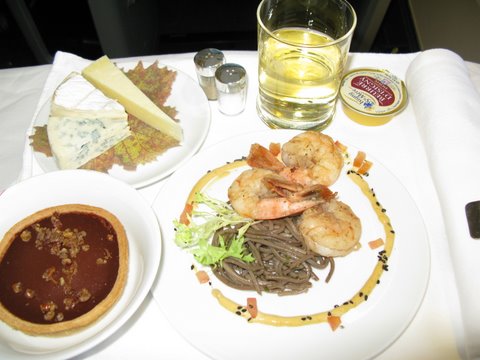April 9th2009 and I am beginning my ten-day journey to Paris, the Champagne Region ofFrance andBelgium. I am flying “l’Espace Affaires” (business class) fromToronto toParis, and looking forward to the “business class travel” experience with Air France.
Settling into a large comfortable seat with a welcoming glass of Champagne, a copy of the Air France in-flight magazine gets me into a “Parisian” mood. The magazine consists of Paris spring fashion trends, locations of the best restaurants as well as comments on what is going on in the art scene. This in-flight mag is a fashionista’sdream come true; lots of French-styled shoes, dresses, purses…. In between sips of Deutz Brut Classic, I’m handed a dinner menu by one of the coiffed, well-mannered staff. I am pleased see that that the flight attendants speak both French and English without hesitation.
The wine offerings are superior. What a nice surprise to see more space on the dining menu devoted to the wine list than to the food. There is also a note on the menu that the wines have been chosen by Olivier Poussier, World’s Best Sommelier in 2000. This is an added bonus. The attendants place white linen table cloths on our tables, immediately followed by fresh and delicious baguettes with creamy butter. I choose Saint-Veran Chateau de Fuisse 06 a niceBurgundy, to pair with the seafood hors d’oeuvre of marinated shrimp served with miso and ginger sauce and serving of soba noodles.
The main course of grilled tournedos of beef with scallion butter, potatoes au grain, broccoli and tomato truly melts in my mouth, particularly paired with a glass of Clos Triguedina Cuvee Prince Probus 05. This is another perfect match and an excellent choice with meat and game-nice intensity and refinement.
Fine china, silver and an impressive wine list coupled with first class service, make me feel like I am in an exclusive restaurant, not on an airplane. I skip coffee and chocolate torte, and decide to get a few hours of sleep. I found sleeping a delightful restful experience due to the tilted seats that turn into a perfect horizontal position and pillows and quilts are quite abundant. Within a few hours I awaken to the smell of fresh coffee brewing…Y E S I’m almost in Paris.The French-style breakfast consisted of juice, yogurt, fresh fruits with pastries and lots of coffee – so perfect!
My Air France Business Class experience has truly proven to be crossing the ocean in style!
Liz Palmer

